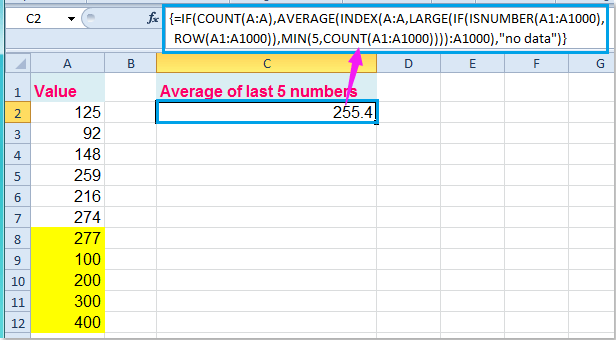열의 마지막 5개 값을 새로운 숫자가 입력될 때 평균하는 방법은 무엇입니까?
Excel에서는 Average 함수를 사용하여 열의 마지막 5개 값의 평균을 빠르게 계산할 수 있지만, 종종 원래 데이터 뒤에 새 숫자를 입력해야 할 때가 있습니다. 이때 새 데이터가 입력됨에 따라 평균 결과가 자동으로 변경되기를 원합니다. 즉, 중간중간 숫자를 추가하더라도 항상 데이터 목록의 마지막 5개 숫자를 반영하는 평균을 유지하고 싶다는 의미입니다.
수식을 사용하여 열의 마지막 5개 값을 새로운 숫자가 입력될 때 평균하기
 수식을 사용하여 열의 마지막 5개 값을 새로운 숫자가 입력될 때 평균하기
수식을 사용하여 열의 마지막 5개 값을 새로운 숫자가 입력될 때 평균하기
다음 배열 수식이 이 문제를 해결하는 데 도움이 될 수 있습니다. 아래 단계를 따르세요:
빈 셀에 다음 수식을 입력하세요:
=IF(COUNT(A:A),AVERAGE(INDEX(A:A,LARGE(IF(ISNUMBER(A1:A10000),ROW(A1:A10000)),MIN(5,COUNT(A1:A10000)))):A10000),"no data") (A:A는 사용 중인 데이터가 포함된 열이고, A1:A10000은 동적 범위로 필요에 따라 확장할 수 있으며, 숫자 5는 마지막 n값을 나타냅니다.), 그런 다음 Ctrl + Shift + Enter 키를 함께 눌러 마지막 5개 숫자의 평균을 구하세요. 스크린샷 보기:

이제 원래 데이터 뒤에 새 숫자를 입력하면 평균이 그에 따라 업데이트됩니다. 스크린샷 보기:

참고: 셀 열에 0 값이 포함되어 있고 마지막 5개 숫자에서 0 값을 제외하려는 경우 위의 수식은 작동하지 않습니다. 여기서는 마지막 5개의 비영(非零) 값의 평균을 구하는 또 다른 배열 수식을 소개하겠습니다. 다음 수식을 입력하세요:
=AVERAGE(SUBTOTAL(9,OFFSET(A1:A10000,LARGE(IF(A1:A10000>0,ROW(A1:A10000)-MIN(ROW(A1:A10000))),ROW(INDIRECT("1:5"))),0,1))), 그런 다음 Ctrl + Shift + Enter 키를 눌러 필요한 결과를 얻으세요. 스크린샷 보기:

관련 기사:
Excel에서 매 5행 또는 매 5열을 평균하는 방법은 무엇입니까?
Excel에서 상위 또는 하위 3개 값을 평균하는 방법은 무엇입니까?
최고의 오피스 생산성 도구
| 🤖 | Kutools AI 도우미: 데이터 분석에 혁신을 가져옵니다. 방법: 지능형 실행 | 코드 생성 | 사용자 정의 수식 생성 | 데이터 분석 및 차트 생성 | Kutools Functions 호출… |
| 인기 기능: 중복 찾기, 강조 또는 중복 표시 | 빈 행 삭제 | 데이터 손실 없이 열 또는 셀 병합 | 반올림(수식 없이) ... | |
| 슈퍼 LOOKUP: 다중 조건 VLOOKUP | 다중 값 VLOOKUP | 다중 시트 조회 | 퍼지 매치 .... | |
| 고급 드롭다운 목록: 드롭다운 목록 빠르게 생성 | 종속 드롭다운 목록 | 다중 선택 드롭다운 목록 .... | |
| 열 관리자: 지정한 수의 열 추가 | 열 이동 | 숨겨진 열의 표시 상태 전환 | 범위 및 열 비교 ... | |
| 추천 기능: 그리드 포커스 | 디자인 보기 | 향상된 수식 표시줄 | 통합 문서 & 시트 관리자 | 자동 텍스트 라이브러리 | 날짜 선택기 | 데이터 병합 | 셀 암호화/해독 | 목록으로 이메일 보내기 | 슈퍼 필터 | 특수 필터(굵게/이탤릭/취소선 필터 등) ... | |
| 15대 주요 도구 세트: 12 가지 텍스트 도구(텍스트 추가, 특정 문자 삭제, ...) | 50+ 종류의 차트(간트 차트, ...) | 40+ 실용적 수식(생일을 기반으로 나이 계산, ...) | 19 가지 삽입 도구(QR 코드 삽입, 경로에서 그림 삽입, ...) | 12 가지 변환 도구(단어로 변환하기, 통화 변환, ...) | 7 가지 병합 & 분할 도구(고급 행 병합, 셀 분할, ...) | ... 등 다양 |
Kutools for Excel과 함께 엑셀 능력을 한 단계 끌어 올리고, 이전에 없던 효율성을 경험하세요. Kutools for Excel은300개 이상의 고급 기능으로 생산성을 높이고 저장 시간을 단축합니다. 가장 필요한 기능을 바로 확인하려면 여기를 클릭하세요...
Office Tab은 Office에 탭 인터페이스를 제공하여 작업을 더욱 간편하게 만듭니다
- Word, Excel, PowerPoint에서 탭 편집 및 읽기를 활성화합니다.
- 새 창 대신 같은 창의 새로운 탭에서 여러 파일을 열고 생성할 수 있습니다.
- 생산성이50% 증가하며, 매일 수백 번의 마우스 클릭을 줄여줍니다!
모든 Kutools 추가 기능. 한 번에 설치
Kutools for Office 제품군은 Excel, Word, Outlook, PowerPoint용 추가 기능과 Office Tab Pro를 한 번에 제공하여 Office 앱을 활용하는 팀에 최적입니다.
- 올인원 제품군 — Excel, Word, Outlook, PowerPoint 추가 기능 + Office Tab Pro
- 설치 한 번, 라이선스 한 번 — 몇 분 만에 손쉽게 설정(MSI 지원)
- 함께 사용할 때 더욱 효율적 — Office 앱 간 생산성 향상
- 30일 모든 기능 사용 가능 — 회원가입/카드 불필요
- 최고의 가성비 — 개별 추가 기능 구매 대비 절약